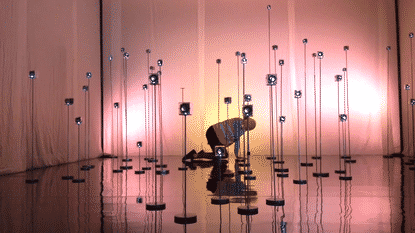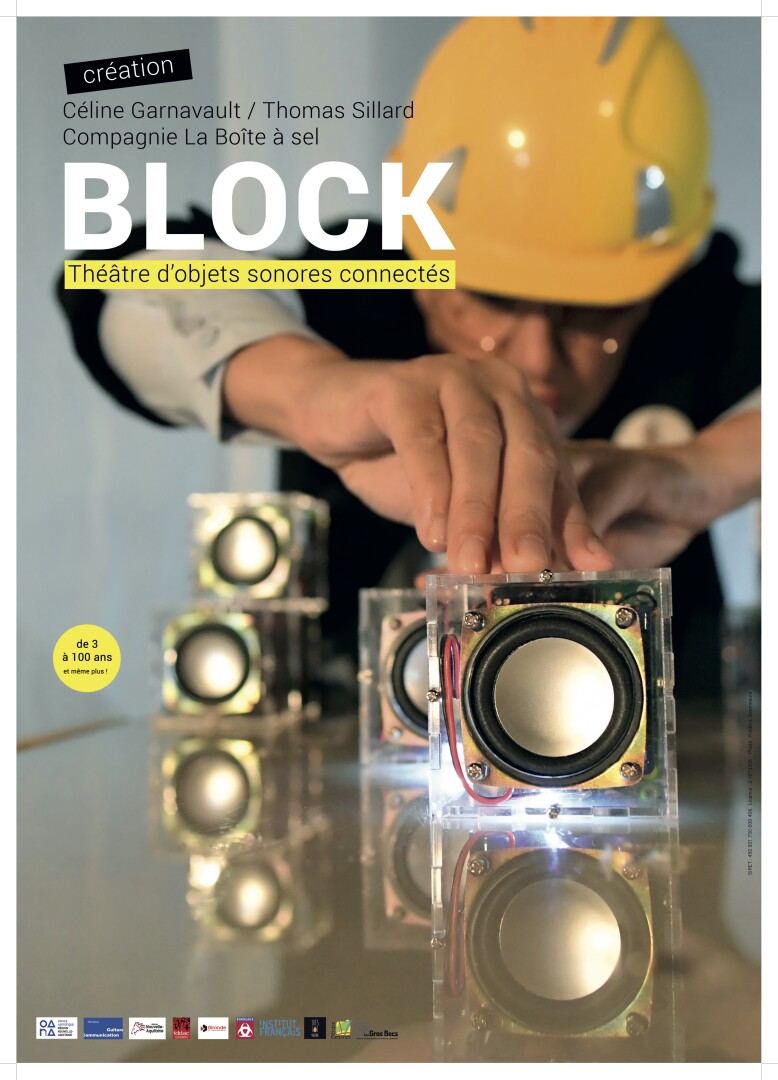 “Our perception of space depends as much on what we hear as on what we see.” Max Neuhaus
“Our perception of space depends as much on what we hear as on what we see.” Max Neuhaus
NOTE D'INTENTION
The blocks appear to be construction pieces, inert, transparent, almost empty except for a few wires and a circuit board that can be seen behind the round speaker on the front.
They are boxes, sound boxes, concrete and rudimentary powered by batteries, like moo boxes, which only work if turned upside down. Their synchronicity - the action of the hand/reaction sound of the block is effective, funny, and simple. Nothing complicated, therefore. We master it.
Then they multiply, and by their number begin to form a mass, their sounds become more complex, develop, intertwine, and project the audience into other urban spaces and other times. Similarly, the performer builds with them increasingly complicated architectures, plastic constructions, bright cities, noisy, bustling with activity, yet without any human figure ever appearing...
Now we must sort, organize, and keep this constantly changing “thing” urban in order, attempt to direct, contain what escapes, and this sound volume that can no longer be controlled...
But what does the architect do when, after so much effort, the city she has created no longer sleeps and prevents her from resting? When the blocks suddenly no longer obey her, resist through sound, inertia, vibration, light? And what if the blocks suddenly rebelled? Wouldn't that be a revolution? The revolt of the workers? What would animate them? How to understand each other and build something else together?
So many questions I wish to explore in a dramaturgy of the object and sound that I want to be innovative, playful, poetic, always unexpected and remaining as open as possible for the projections and imagination of the spectators.
Céline Garnavault, director and performer
Sound creation, the blocks: sound and connected architectures
When Céline told me about her desire for a show about the city in which sound would be an integral part of the dramaturgy, my first thought was: how to represent the city? Knowing Céline's work on the object, the material, I sought a way to make sound palpable, manipulable, plastic, playful, within reach...
The city is composed of a multitude of sounds and sound emitters: horns, cars, voices, construction, planes, footsteps, parks, etc... I proposed to transpose this multitude of emitters through small cubic speakers, the most basic shape, that of the speaker, of the sound emitter as we know it. A recognizable sign for everyone and at the same time easily manipulable, like a child's cube, a construction block that brings play and interaction between the performer and the object: the blocks were born.
Unlike what is usually done in sound - where two speakers reproduce a stereo sound space, giving the illusion of a horizontality and depth - we will seek, through the multiplication of these small sound sources called blocks, to compose a whole, which will no longer be an illusion, but which through the accumulation of these details will create a scene, a sound image, in the literal sense that will make sense and play. In the manner of small figurines that compose a whole universe in children's games: from the multitude of figures arises an overall picture, a projection of their imaginary worlds.
These objects must be manipulable and interact with the performer, I quickly thought of “the moo box,” a very concrete toy, whose synchronicity and simplicity are very effective dramaturgically and create “theater” both for the one manipulating it and for the one watching, hearing it. They will therefore need to operate on this principle of action/reaction.
Finally, the choice of transparency for these objects became evident during our research in Montreal, for what it brings of generic, neutrality, beauty, what it allows in terms of light, and the nod to the visible printed circuits: “how does it work” for children who love to dismantle everything to understand, but also echoing the modern, technological world and the new mirror constructions of our cities today.
Based on these plastic, sound, and technological choices, we wish to explore different dramaturgical avenues, to articulate a language and a logic specific to these objects, to our space and our address to the audience. The blocks at the start of the narrative will construct sound spaces characterizing atmospheres (construction site, countryside, crowd, city, building at night, rain, etc...) they will be the decor. Then they will change status, gradually coming to life and becoming the actors of the story until they overturn the one that gave them their first impulse.
We still need to perfect and manufacture the blocks, about sixty of them. I will therefore partner with different designers to create efficient and reliable objects, emitters of sounds and lights and interconnected.
Thomas Sillard, designer of the blocks, sound creator

